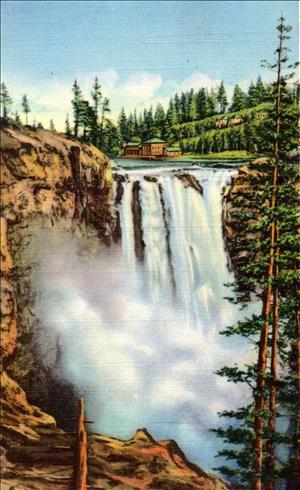On June 9, 1903, Snoqualmie incorporates as a town of the fourth class. Located in eastern King County nearly 30 miles east-southeast of Seattle, Snoqualmie will be a small rustic community known for logging, farming, and scenic Snoqualmie Falls for nearly all of its first 100 years. This will change dramatically in the early 2000s, when the development of Snoqualmie Ridge will cause the city's population to skyrocket by more than 600 percent between 2000 and 2010.
Beginnings
In 1855 the Snoqualmie Tribe ceded its land in the Snoqualmie Valley to the United States under the terms of the Point Elliott Treaty. It was inevitable that non-Native settlement would follow, and the first such permanent settler is considered to be Jeremiah Borst (1830-1890). He settled in the valley in 1858, initially living in the ruins of Fort Alden, a crude wooden fort that had been hastily built a couple of years earlier by Washington Territorial Volunteers during the 1855-1856 Indian Wars.
Loggers arrived in the area during the 1870s. Watson Allen opened Snoqualmie's first mill about 1872 at the mouth of Tokul Creek, just downstream from Snoqualmie Falls. (Allen's name appears in other places in King County's early logging history, including in 1889 when he cofounded the Allen and Nelson Mill Company in Monohon on the southeastern shore of Lake Sammamish.) Other logging camps followed, and although hop farming briefly flourished in the 1880s and 1890s, Snoqualmie remained a nascent community during these years.
It took the arrival of the Seattle, Lake Shore & Eastern Railway in 1889 to spur valley residents to plat "Snoqualmie Falls" in August of that year. The plat was filed by Charles H. Baker (1864-1926), an engineer with the railway who a decade later developed the power plant at Snoqualmie Falls. The first lots are said to have been bought by Edmund and Louisa Kinsey, parents of Darius (1869-1945) and Clark (1877-1956) Kinsey, two well-known photographers of the region's lumber industry between the mid-1890s and 1940.
Name Change and Incorporation
The community later shortened its name to Snoqualmie, and by May 1903 it had grown enough to hold an election on whether to incorporate. The proposal passed by a comfortable margin of 49 to 20, and the incorporation documents were filed on June 9, 1903. James Strouf was the town's first mayor and J. M. Ryley its first treasurer. The town's first five councilmemebers were Alfred F. Kinsey (brother to Darius and Clark), John Lawson, William McLeod, C. L. Somers, and Herman Weiting.
The new council had its work cut out for it. Lots in Snoqualmie were overpriced at $300 each, as they had been since the town was platted in 1889. Many residents hadn't bothered to buy a lot, and instead built on vacant land and in the rights-of-way of the town's streets. Lot prices were eventually lowered, and the town began the long abatement process to move houses and businesses from where they did not belong.
Logging, Farming, Filming
Logging continued to dominate the Snoqualmie economy into the twentieth century. Dairies and other farms replaced the hop farms of the late nineteenth century, and an underground power plant at Snoqualmie Falls opened in 1899, followed in 1917 by an all-electric lumber mill in the small company town of Snoqualmie Falls (just across the Snoqualmie River from Snoqualmie). The little community's population grew from 279 in 1910 to 1,216 in 1960.
Between 1960 and 2000 Snoqualmie's population drifted up to 1,631, but life in the valley was quiet and stable for most of those years. Many young people left for the charms of Seattle or other large cities, while some who stayed found work in a Weyerhaeuser plywood plant. Perhaps the biggest thing that happened in those decades came in 1990 and 1991, when the popular television mystery series Twin Peaks was filmed at locations in Snoqualmie (as well as nearby North Bend and Fall City).
Dramatic Changes
The sleepy scene changed dramatically later in the 1990s, when Snoqualmie annexed 1,300 acres of land west of the city for the planned community of Snoqualmie Ridge. The first homes opened in 1998, but the real growth occurred between 2000 and 2010. Snoqualmie's population grew more than 600 percent, from 1,631 to 10,670, making it hands-down the city with the fastest growth rate in the state during the first decade of the twenty-first century. On the ridge, houses and condominium units were built at a rate of more than 300 a year during several years in the early 2000s, though the Great Recession late in the decade significantly slowed the boom.
The new residents on Snoqualmie Ridge had little in common with their neighbors in the valley. A 2006 survey brought this out in stark detail: More than half of the households in the valley reported annual incomes of less than $50,000, while on the ridge two-thirds of the households reported annual incomes exceeding $100,000. There was contention and resentment between the two groups, which increased when the city built a new fire station and library on the ridge and talked of raising taxes to pay for new schools there. Still, it was almost a moot point by 2010: More than 80 percent of Snoqualmie's residents lived on Snoqualmie Ridge by then, and this growth would continue (at a somewhat slower pace) during the following decade.

